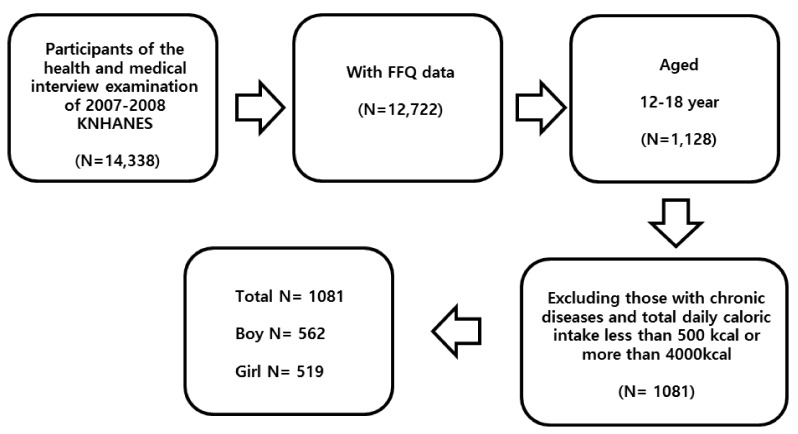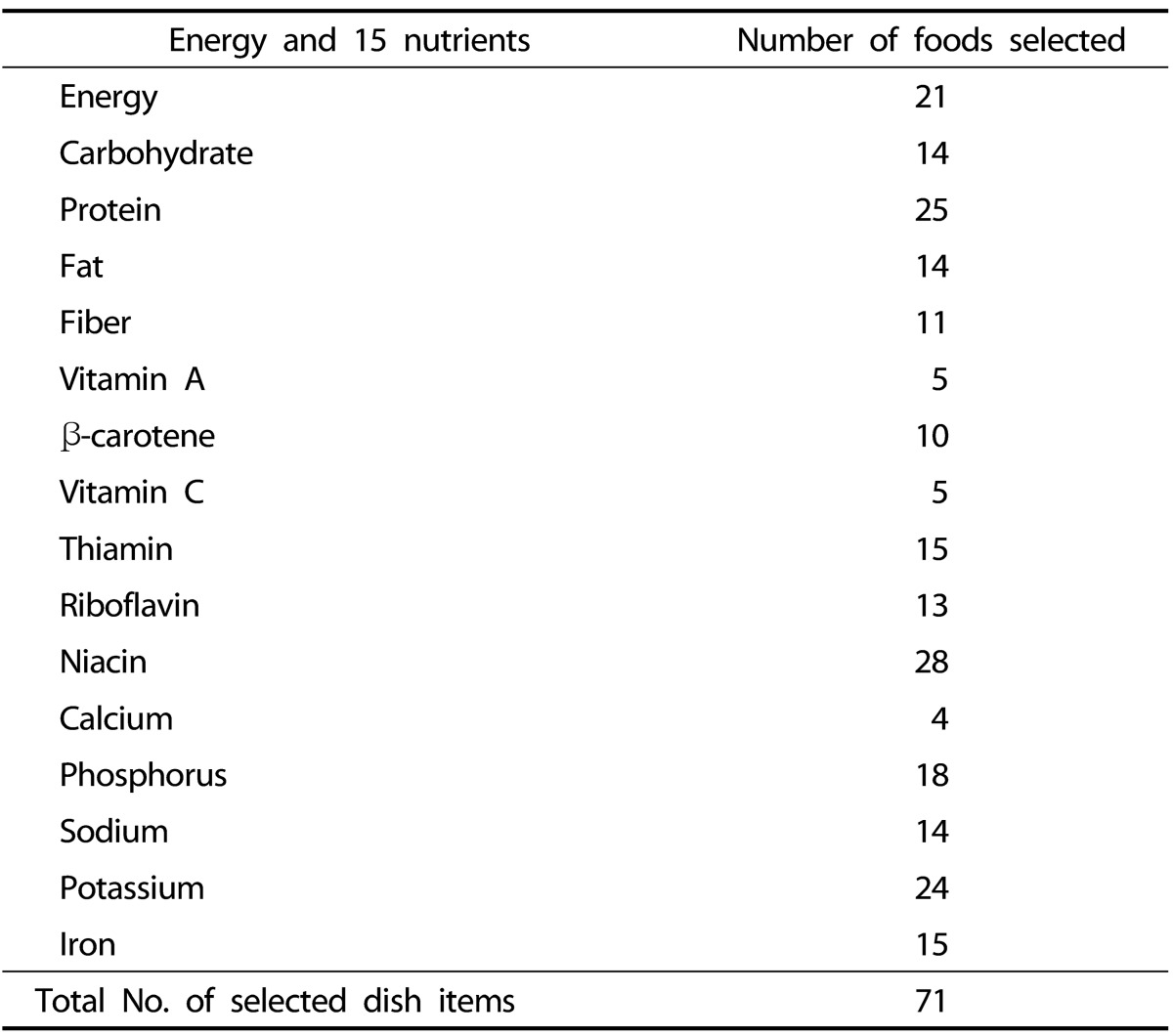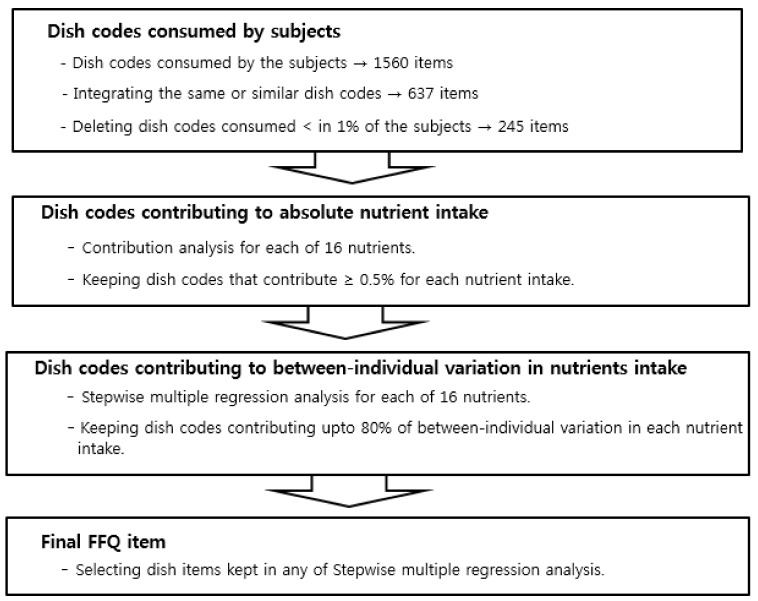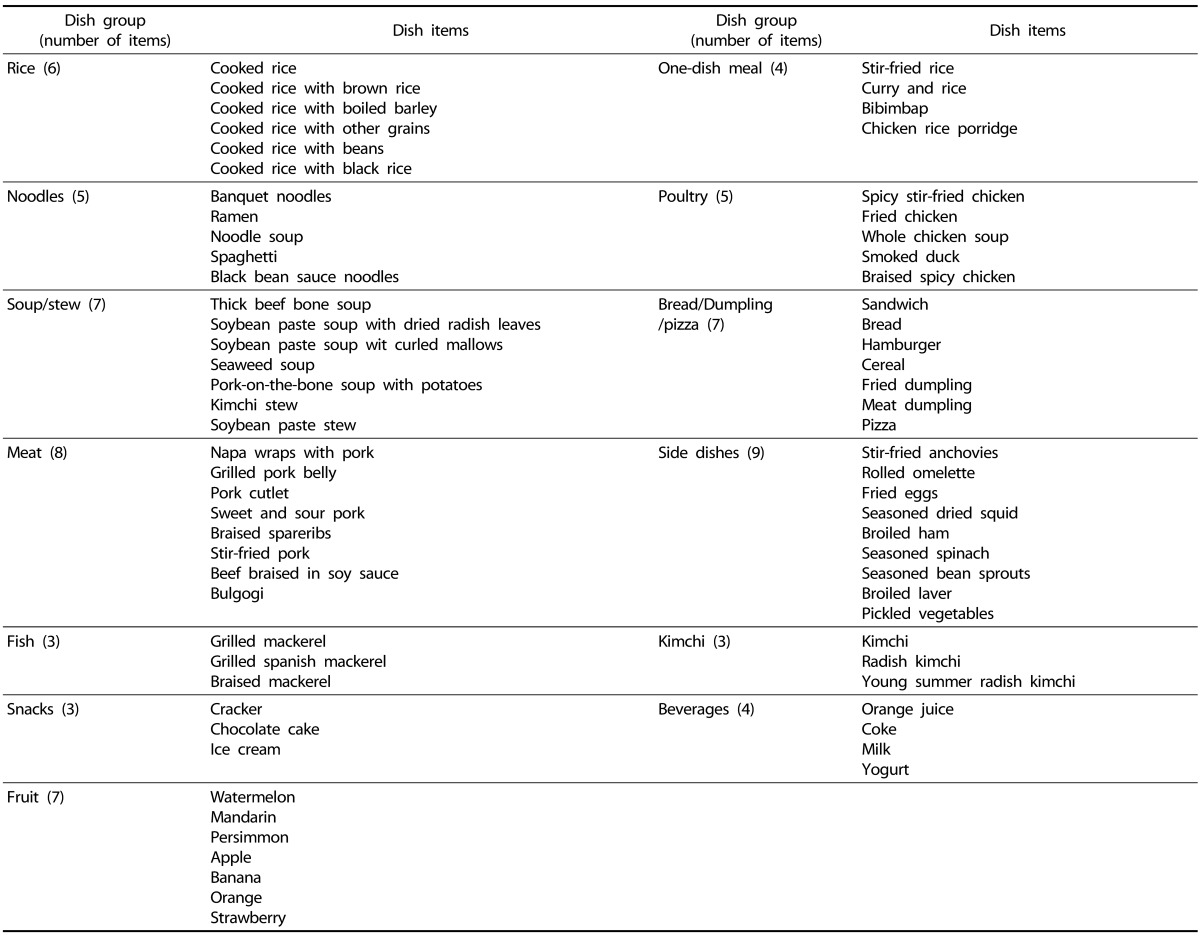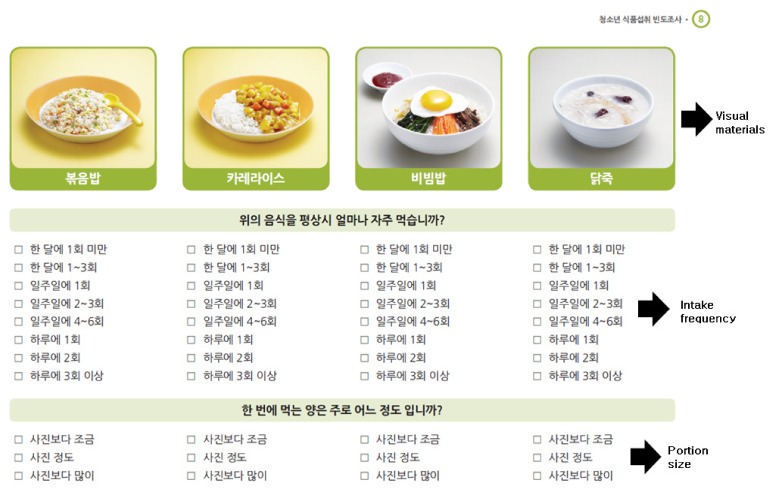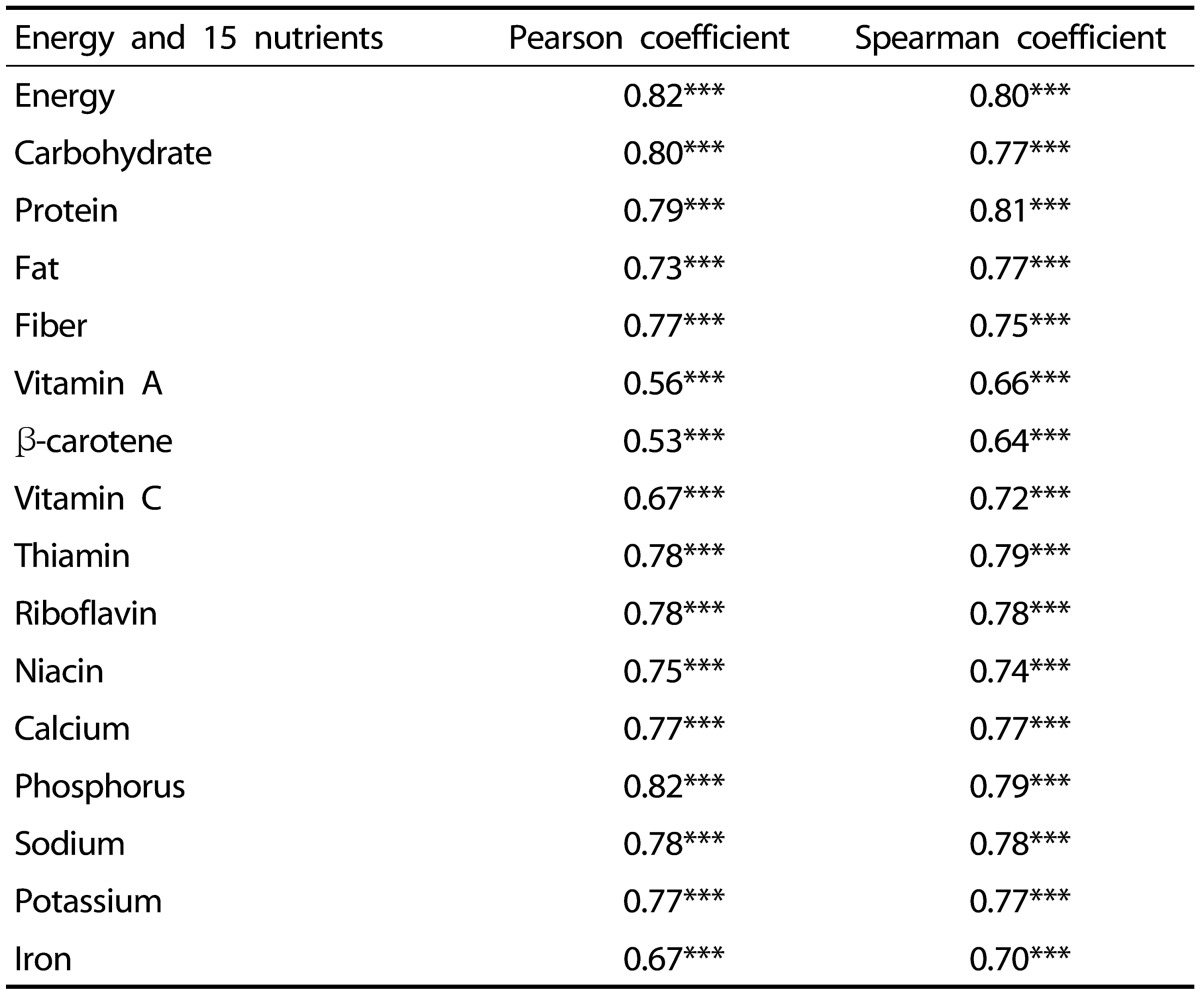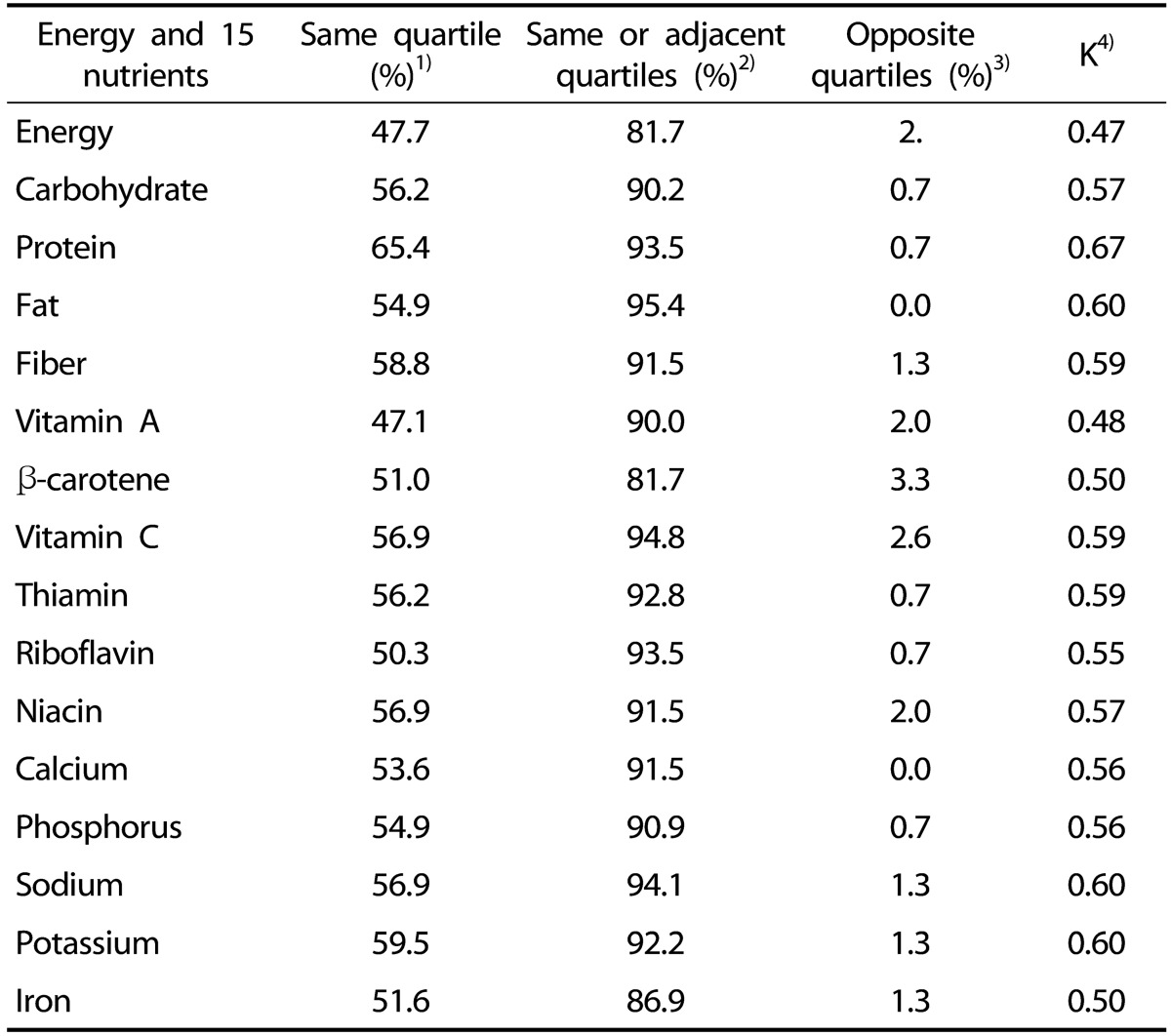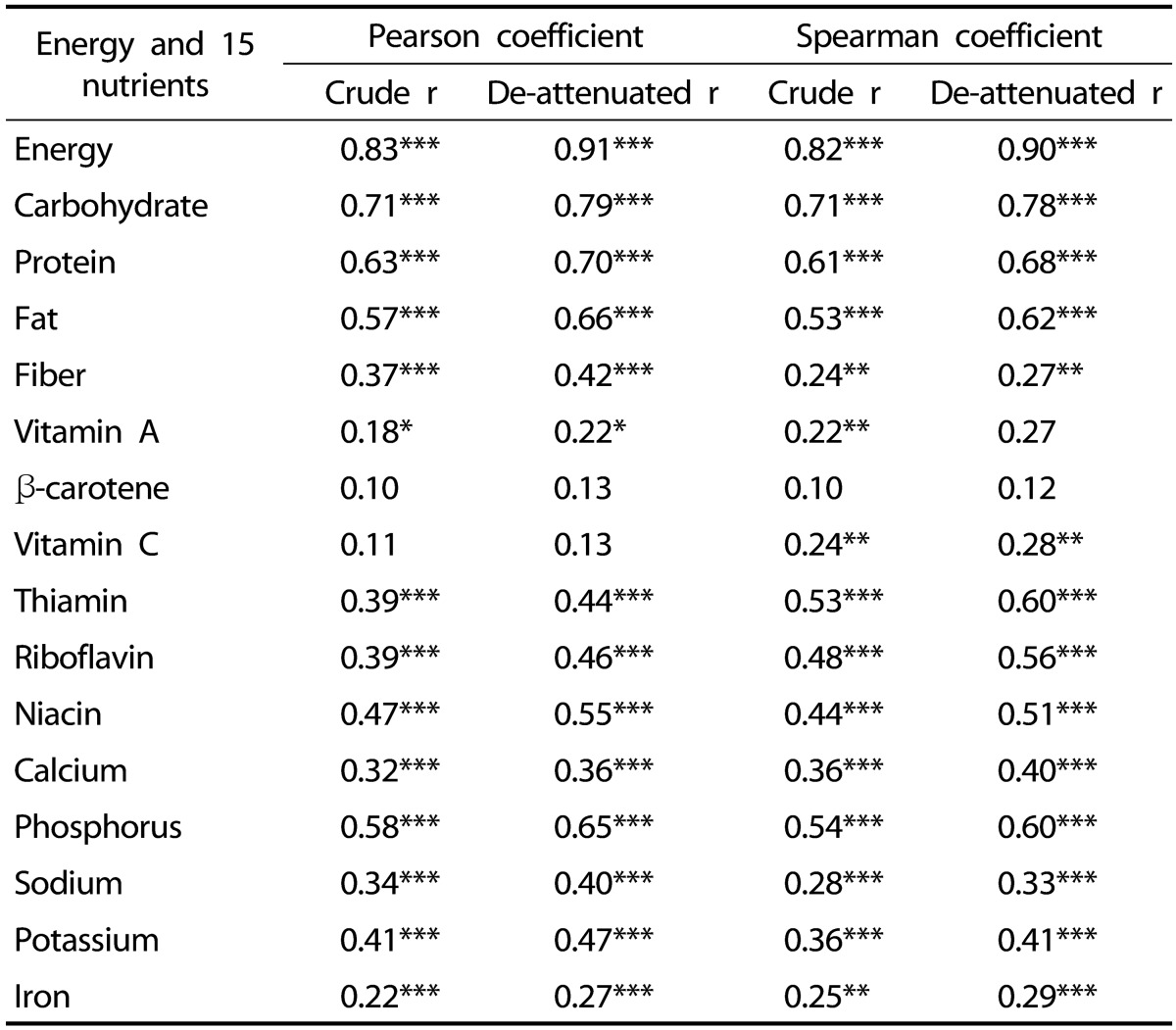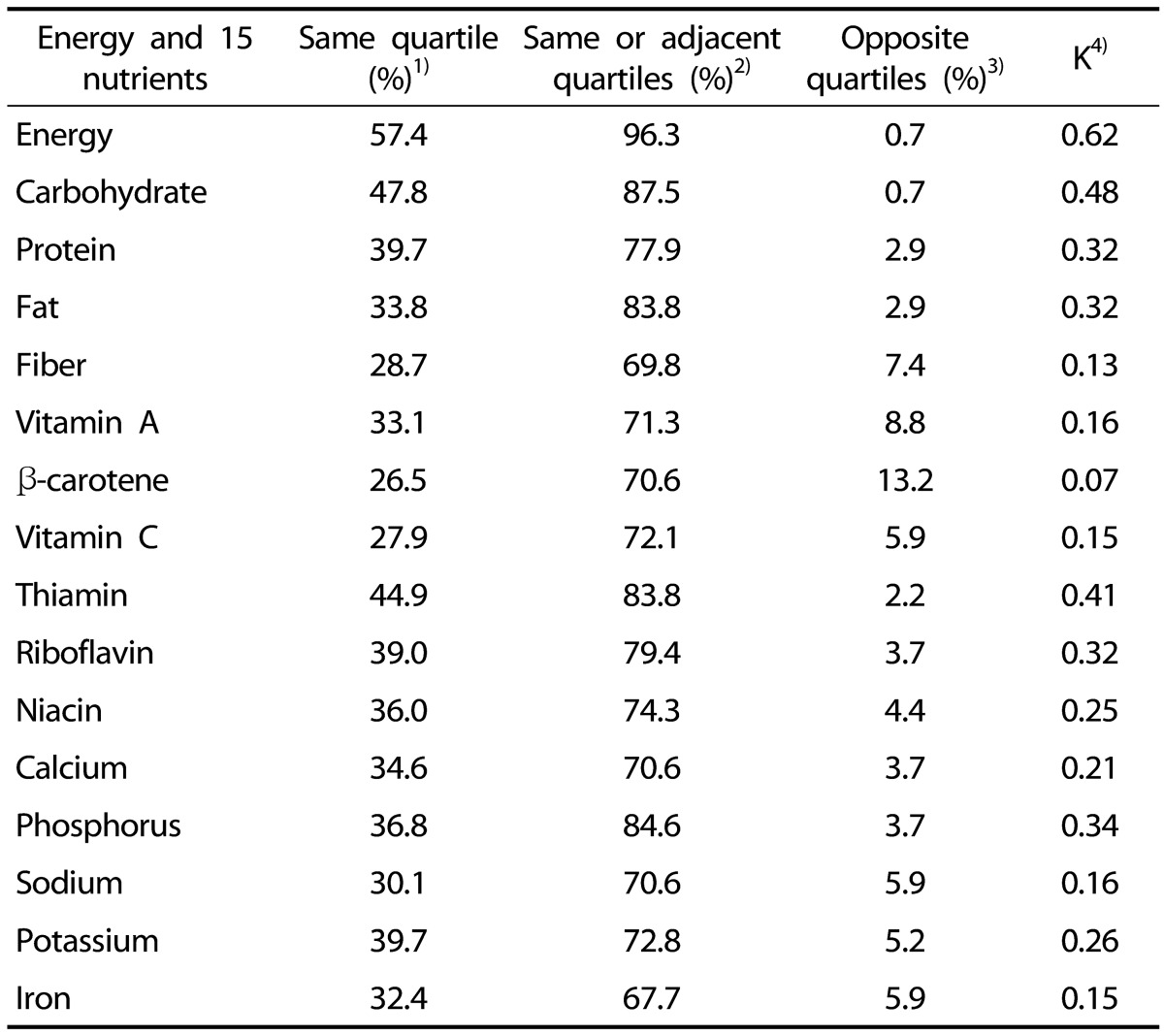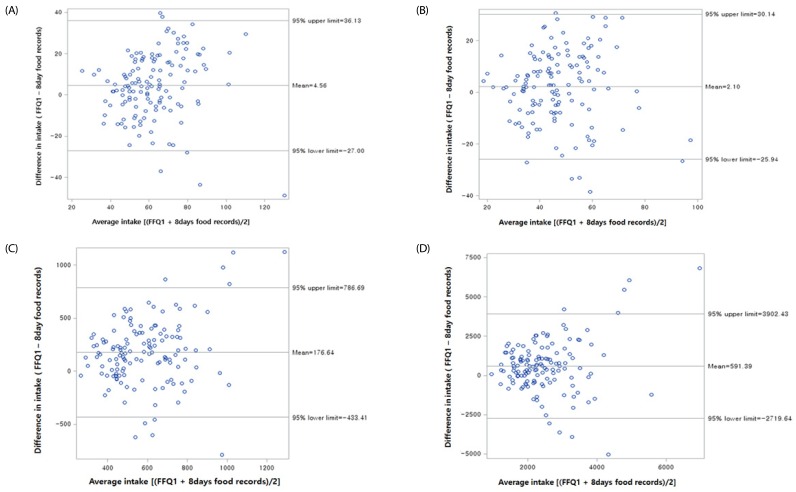Abstract
BACKGROUND/OBJECTIVES
The purpose of this study was to develop a dish-based semiquantitative food frequency questionnaire s(FFQ) for Korean adolescents and evaluate its reproducibility and validity.
SUBJECTS/METHODS
Based on 24-hour dietary recall data from the 4th Korean National Health and Nutrition Examination Survey (KNHANES), we developed a FFQ with 71 items. From a quota sample of 160 adolescents recruited using gender and age group as stratification variables, 153 participated in the complete data collection process. The FFQ was administered to each subject twice, at an interval of 3-4 weeks, to evaluate the test-retest reliability. The validity of the FFQ was assessed relative to 8-day food record data.
RESULTS
The study findings demonstrated the FFQ's satisfactory reproducibility. Spearman correlation coefficients ranged from 0.64(for β-carotene) to 0.81(for protein). From cross-classification analyses, the proportion of subjects in the same intake quartile was highest for protein (65.4%) and lowest for vitamin A(47.1%). With regard to validity analysis, Spearman correlation coefficients ranged from 0.27(for vitamin A and fiber) to 0.90 (for energy). The proportions of subjects in the opposite categories between the first FFQ and the 8-day food record data were generally low within the range from 0.74% (for energy and carbohydrate) to 13.2% (for α-carotene).
CONCLUSIONS
In conclusion, the dish-based semiquantitative FFQ developed in this study can be useful for grouping Korean adolescents according to major macro- and micronutrient intakes with reasonable reproducibility and validity.
Keywords: Adolescent, FFQ, reproducibility, validity
INTRODUCTION
Investigations of the effects of diet on the prevention and occurrence of diseases require a tool for reasonably assessing the dietary intake. In the case of chronic diseases, it is necessary to understand the dietary intake over an extended period, and the food frequency method, which reflects long-term dietary intake, is normally used. The food frequency questionnaire (FFQ) also needs to reflect dietary characteristics of the target population [1].
The results of a recent survey indicate that Korean adolescents do not consume the recommended nutrient intakes of calcium, vitamin A, riboflavin, and vitamin C. Furthermore, 18%, 21.5%, and 80% of adolescents consume more than the dietary reference intake levels of energy, fat, and sodium, respectively, which indicates the presence of nutritional imbalance problems with Korea adolescents [2]. According to an analysis of the 2005 and 2013 Korean National Health and Nutrition Examination Survey (KNHANES) applied to representative Korean samples, the dietary pattern of Korean adolescents changed rapidly during the 8-year period: the daily intake of vegetables decreased from 260 g to 214 g, the intake of fruit increased from 80 g to 140 g, and the intake of animal foods increased from 279 g to 396 g. These changes illustrate the dynamic dietary pattern of Korean adolescents. Comparing the average daily nutrient and dietary intakes between adolescents aged 12-18 years and adults aged 30-49 years according to the 2013 KNHANES revealed that the intake of certain micronutrients (e.g., calcium, iron, and potassium) is much lower for adolescents than for adults. In terms of food groups, the intake of plant foods was lower and that of animal foods was higher for adolescents than for adults, revealing a clear distinction between these two age groups [2,3]. Therefore, a dietary research tool is needed for conducting systematic research into the nutritional status of adolescents, who are characterized by a dynamic and distinct dietary consumption relative to other life cycle groups.
FFQs for adolescents have been widely developed and evaluated worldwide [4,5,6,7]. Rockett et al. [4] developed an FFQ for American adolescents aged 9-18 years with 116 items-including food that is frequently consumed in this age group-in order to understand their general diet. The reproducibility over a 1-year period was found to be acceptable. Yaroch et al. [5] developed an FFQ for low-income African-American adolescents aged 11-17 years for application in a dietary survey. In addition to FFQs focusing on the overall diet, FFQs have been developed for understanding the intake of specific nutrients or food groups, and such research has shown that FFQs can be useful in evaluating the diet of school-age children and adolescents [8,9,10,11,12]. However, the large differences between the food cultures of Korea and other countries imply that foreign FFQs cannot be applied to Korean adolescents [1]. While several studies have (Ed- or 'While extensive research has') been conducted to develop FFQs for Korean adults and elderly since the mid-1990s [13,14,15,16,17,18,19], only a few studies have developed FFQs for Korean adolescents [20].
Therefore, the present study aimed to develop a semiquantitative FFQ for Korean adolescents and evaluate its reproducibility and validity. The FFQ was designed to assess intake levels of major macro- and micronutrients based on dish-based items.
SUBJECTS AND METHODS
Development of the FFQ
Subjects
The FFQ development stage of this study utilized data from the first and second years (2007 and 2008, respectively) of the fourth KNHANES. The KNHANES consists of three sections: health examination, health interview, and nutrition survey. This study used the 24-hour recall data of the KNHANES that were obtained through individual interviews by trained nutritionists.
Out of 14,338 subjects who participated in the health questionnaire and health examination survey, dietary data from 1,081 subjects (562 males and 519 females) aged 12-18 years who did not have major chronic diseases such as cancer, diabetes, or myocardial infarction were used after excluding calorie intakes of less than 500 kcal or more than 4,000 kcal [4,20,23,30,31] (Fig. 1).
Fig. 1. Sampling process of the study subjects for developing the FFQ.
The KNHANES was approved by the KCDC Institutional Review Board (IRB). (IRB: 2007-02CON-04-P; 2008-04EXP-01-C) All participants provided written informed consent. Participation was voluntary and all records were anonymized before analysis.
Selection of FFQ dish items
Selection of the FFQ items was based on the dish codes of the dietary data rather than food codes, due to the common use of multiple food ingredients in Korean dishes, the convenience of diet recollection, and the accuracy the nutrient intake estimation. The food items included in the questionnaire were selected by first individually examining each of the 1,560 dish codes that appeared in the 24-hour recall data of the 1,081 subjects. In this examination, the 1,560 dish codes were reduced to 637 after combining dishes with identical or similar and content, and then to 245 after eliminating those consumed by fewer than 1% of the subjects [31].
In order to select the major items that contribute to the absolute nutrient intake, a contribution analysis was conducted for energy and 15 nutrients, including macronutrients and micronutrients, that are listed in Table 1. Dish codes that contribute less than 0.5% of the total intake of each nutrient were then eliminated [1,31,32]. A stepwise multiple regression analysis was subsequently conducted with the independent variables being the dish codes that remained after the contribution analysis. Dish codes that constituted 80% of the nutrient intake were retained. Out of the 16 stepwise multiple regression analyses, dish codes that remained at least once were selected as the final FFQ items. Also, 4 types of fruit were added to the item list because the fruit intake changes markedly according to season, resulting in the final selection of 71 items (Fig. 2).
Table 1. Number of dish items selected for the food frequency questionnaire (FFQ) by stepwise multiple linear regression for energy and each nutrient.
Fig. 2. Selection of dish items for inclusion in the FFQ.
Selection of intake frequency and portion size
The standard portion size consumed per meal and a representative recipe for each selected item were derived based on the frequency of appearance and average intake of each food code implicated in the FFQ item. For the standard portion size, non-intakers' data were not taken into account to improve the representativeness of actual consumption pattern. When numerous food codes were implicated due to the inclusion of various recipes, the food codes were chosen by combining the appearance frequency of similar ingredients according to their weight. Food ingredients reported by fewer eaters (i.e., less than 20% of the total appearance frequency for that dish code) were eliminated to enhance the simplicity and representativeness of the recipes. Hence, overestimation of the food weight was prevented by avoiding the simple addition of the average amount for each food ingredient used. For each FFQ item, three categories of portion size were presented to enhance the validity of consumption amount.
Preparation of visual materials for portion size and determination of the overall structure
Visual materials for each FFQ item were produced by conducting experimental cooking with the average recipes prepared as described above, and a photo for each item was taken by a professional photographer. The shape and color of the plates used in the photograph were chosen based on the advice from a food coordinator. A multiple-choice format (i.e., intake frequencies as suggested repeatedly for each item) rather than the conventional FFQ format (i.e., FFQ items placed in the first column and intake frequencies placed in the row) was selected for the overall structure of the FFQ based on a preliminary study.
Evaluating the Reproducibility and Validity of the Developed FFQ
Subjects
Quota sampling, which is a type of nonprobability sampling method, was used to evaluate the reproducibility and validity of the developed questionnaire. With the gender and school type (middle school and high school) of adolescents aged 12-18 years set as stratification variables, 160 subjects were recruited in the same ratio for each stratum. Based on the analysis of the nutrient consumption according to the FFQ and food record data, subjects who had calorie intakes of less than 500 kcal and more than 4,000 kcal, and those who did not complete the questionnaire were excluded, so that data from 153 adolescents were included in the final analysis. This study was approved by the Institutional Review Board of Sungshin Woman University (IRB: sswuirb2011-006). Written informed consents were obtained from each subject.
Data collection
The developed FFQ was administered twice for each subject over a 4-week period. During this period the food record data were obtained over 8 non-consecutive days (6 weekdays and 2 weekend days, twice per week). The data collection was conducted between September and December in 2011. A trained nutritionist provided thorough instructions on how to complete the FFQ and the food record sheet to each subject. For recording in the food record sheet, photographs of commonly used plates, measuring cups, and food photos of actual sizes were handed out in advance.
The food record data for the 8 non-consecutive days were reviewed by the trained nutritionist once a week to ensure recording in time and data quality. Data that were inadequate, imprecise, or contained missing information were augmented by phone or face to face interviews.
Statistical analysis
A Can-pro 4.0 (computer-aided nutritional analysis program, Korean Nutritional Society, 2011; Seoul, Korea) was used to calculate nutrient intakes from the 8-day food records and FFQ, and the reproducibility and validity were analyzed using the Statistical Analysis System program (version 9.2, SAS Institute, Cary, NC, USA).
The reproducibility and validity of the FFQ were determined by calculating the Spearman rank-order and Pearson correlation coefficients. Since the food records used as comparative data in the FFQ validity analysis might have attenuated the validity due to day-to-day variations, the de-attenuated correlation coefficients were calculated. The data were divided into four categories according to the nutrient intake. Cross-classification was then conducted to identify the consistency between the first and second FFQ data, as well as between FFQ and food record data. The corresponding weighted kappa values were calculated. In addition, the Bland-Altman plots were generated to examine the reproducibility and validity of the FFQ. The cutoff for statistical significance was 0.05 in two-tailed testing.
RESULTS
Development of the FFQ
Table 2 lists the 71 finally chosen FFQ items. Considering that adolescents can exhibit a low response rate when the assessment tool involves complicated questions(21) and variations in the frequency choices between different FFQ items may increase the proportion of mistakes, the following eight frequency choices were applied to all 71 items: 'less than once a month,' '1 to 3 times a month,' 'once a week,' '2 to 3 times a week,' '4 to 6 times a week,' 'once a day,' '2 times a day,' and '3 or more times a day.' For the portion size option, three choices of 'less than the amount in the photo,' 'close to the amount in the photo,' and 'more than the amount in the photo' were presented. A part of the developed FFQ is shown in Fig. 3.
Table 2. Food frequency questionnaire (FFQ) items according to dish groups.
Fig. 3. The FFQ format.
Reproducibility Analysis and Validity Testing
Reproducibility
In order to evaluate the reproducibility of the developed FFQ, a correlation analysis was conducted on the nutrient consumption between the first and second FFQs (Table 3). The Pearson correlation coefficients for energy and the 15 nutrient intakes ranged from 0.53 (for β-carotene) to 0.82 (for energy and phosphorus), and the Spearman correlation coefficients ranged from 0.64 (for β-carotene) to 0.81 (for protein). The Pearson and Spearman correlation coefficients were statistically significant for all the nutrients and exceeded 0.7 for most of them, but were slightly lower for vitamin A, β-carotene, vitamin C, and iron.
Table 3. Pearson and Spearman correlation coefficients for energy and 15 nutrients between first and second administrations of the FFQ.
* P < 0.05, ** P < 0.01, *** P < 0.001
From the cross-classification analysis, the proportion of subjects in the same intake category was highest for protein (65.4%), and lowest for vitamin A (47.1%) (Table 4). The proportion of subjects in either same or adjacent categories ranged from 81.7% (for energy and β-carotene) to 95.4% (for fat). The proportion of subjects in the opposite categories between the first and second FFQs ranged from 0.0% (for fat and calcium) to 3.3% (for β-carotene). The consistency between the first and second FFQs was also assessed using weighted kappa values. The highest and lowest values for nutrients were 0.67 for protein and 0.48 for vitamin A, respectively.
Table 4. Agreement proportion in quartile distributions of energy and 15 nutrients between first and second administration of the FFQ.
1) Percentage of subjects in the same quartile of nutrient intakes from FFQ1 and FFQ2
2) Percentage of subjects in the same or adjacent quartiles of nutrient intakes from FFQ1 and FFQ2
3) Opposite (lowest/highest) quartiles
4) Weighted kappa
Fig. 4 shows the Bland-Altman plots for protein, fat, vitamin A and β-carotene intakes between the first and second administrations of the FFQ. The narrowest limits of agreement were found for protein and fat, and the widest for vitamin A and β-carotene. Subject proportions who fell outside of the limits of agreement ranged from 4.6% to 7.8% for all the nutrients examined, indicating generally good agreement.
Fig. 4. Bland-Altman plots showing the relationship between the differences and the averages in daily intake of (A) protein, (B) fat, (C) vitamin A, and (D) β-carotene estimated by first and second administrations of the FFQ.
Validity
The nutrient intakes as estimated from the 8-day food record data and the developed FFQ were compared to test the validity of the FFQ. The Pearson correlation coefficients for energy and the 15 nutrient intakes ranged from 0.22 (for vitamin A) to 0.91 (for energy), and the Spearman correlation coefficients ranged from 0.27 (for vitamin A and fiber) to 0.90 (for energy). The Pearson and Spearman correlation coefficients were statistically significant for all the nutrients except for vitamin C and β-carotene (Table 5).
Table 5. Pearson and Spearman correlation coefficients for energy and 15 nutrients between first administration of the FFQ and 8-day food records.
* P < 0.05, ** P < 0.01, *** P < 0.001
From the cross-classification analysis, the proportion of subjects in the same intake category was highest for energy (57.4%), and lowest for β-carotene (26.5%) (Table 6). The proportion of subjects in either identical or adjacent categories ranged from 67.7% (for iron) to 96.3% (for energy). The proportion of subjects in the opposite categories between the first FFQ and 8-day food record data ranged from 0.74% (for energy and carbohydrate) to 13.2% (for β-carotene). The consistency between the first FFQ and 8-day food record data was assessed using weighted kappa values. The highest value for nutrients and energy was 0.62 for energy and the lowest was 0.07 for β-carotene (Table 6).
Table 6. Agreement proportions in quartile distributions of energy and 15 nutrients between first administration of the FFQ and 8-day food records.
1) Percentage of subjects in the same quartile of nutrient intakes from FFQ1 and 8-day food records
2) Percentage of subjects in the same or adjacent quartiles of nutrient intakes from FFQ1 and 8-day food records
3) Opposite (lowest/highest) quartiles
4) Weighted kappa
Fig. 5 shows the Bland-Altman plots for protein, fat, vitamin A and β-carotene intakes between the 8-day food records and the first administration of the FFQ. The narrowest limits of agreement were found for protein and fat, and the widest for vitamin A and β-carotene. Subject proportions who fell outside of the limits of agreement ranged from 4.4% to 7.4% for all the nutrients examined.
Fig. 5. Bland-Altman plots showing the relationship between the differences and the averages in daily intake of (A) protein, (B) fat, (C) vitamin A, and (D) β-carotene estimated by first administration of the FFQ and 8-day food records.
DISCUSSION
The purpose of this study was to develop and evaluate a dish-based semiquantitative FFQ for Korean adolescents. In the FFQ, 71 items were chosen by analyzing absolute contributions to energy and 15 types of nutrient intake and subsequently screening those contributing to intake variations between individuals.
In the test-retest reproducibility evaluation, the correlation coefficients ranged from 0.53 (β-carotene) to 0.82 (energy), with an average value of 0.74. These relatively high values compared to previous studies reflect the superior reproducibility of the developed FFQ. Rockett et al. [4] evaluated the test-retest reproducibility over 1 year and found that the average correlation coefficients for nutrient and food intakes were 0.41 and 0.49, respectively. An FFQ consisting of 69 items for Belgian adolescents showed reproducibility correlation coefficients ranging from 0.27 to 0.87 (with an average of 0.62) [6]. FFQ development and evaluation studies have also been conducted for FFQs targeting specific nutrients or food groups. Buzzard et al. [8] developed a brief FFQ for understanding the fat, cellulose, fruit, and vegetables intakes of adolescents in a rural area, and reported that the reproducibility coefficients of the developed FFQ were 0.58 for fat, 0.49 for cellulose, and 0.47 for fruit and vegetables. The correlation coefficients for the test-retest reproducibility of another simple FFQ created for understanding the fruit and vegetable intakes of high elementary graders in Korea ranged from 0.22 to 0.64 [22].
In addition to correlation analysis, the present study also investigated the classification consistency of the test-retest reproducibility. The consistency rates ranged from 47.1% (for vitamin A) to 65.4% (protein), the proximal proportions ranged from 81.7% (energy and β-carotene) to 95.4% (fat), and the inconsistent proportions were in the low range of 0.0% (fat) to 3.33% (β-carotene). The corresponding weighted kappa values ranged from 0.47 (energy) to 0.67 (protein). These values are higher than those reported by Zhuang et al. [23] based on classifying the nutrient intake into four groups 0.20-0.44. Vereecken and Maes conducted a development and evaluation study of a simple FFQ with 15 items focusing on the intakes of cellulose, calcium, and some unhealthy food items [9]. Among Belgian adolescents, the weighed kappa values ranged from 0.43 to 0.70, which are similar to the values found in the present study. These literature comparisons indicate that the reproducibility was satisfactory in terms of classification consistency.
In order to evaluate the validity of this FFQ, the first FFQ and the 8-day dietary records were compared. For the nutrient intake measured using these two methods, the de-attenuated Spearman correlation coefficients ranged from 0.12 (β-carotene) to 0.90 (energy), with an average of 0.48. All the macronutrients and several micronutrients such as phosphorus, thiamine, riboflavin, and niacin had correlation coefficients of at least 0.5, indicating high validity. Fiber, vitamin A, vitamin C, and iron had relatively lower correlation coefficients, of less than 0.3, and β-carotene did not show a significant correlation.
An FFQ developed to target low-income African-American adolescents was shown to have de-attenuated and energy-adjusted correlation coefficients of approximately 0.6 for most nutrients in comparison with 24-hour recall [5]. An earlier Korean study of adolescents' FFQ reported higher validity correlation coefficients for macronutrients and micronutrients compared to those in the present study [20]. However, it was consistent with our study that correlations coefficients for macronutrients were generally higher compared to those for micronutrients. In other studies, the correlation coefficient of vitamin A was 0.36 [24] and 0.37 [25], which is lower than that for other nutrients, and for an Iranian FFQ, the correlation coefficient for vitamin A was reported to have a negative value [26]. This could be partly due to the intake amount varying markedly according to the food type for micronutrients in comparison to calorie nutrients.
The validity based on classification consistency revealed that the consistent proportion ranged from 26.5% (β-carotene) to 57.4% (energy), the proximal proportion from 67.7% (iron) to 96.3% (energy), and the inconsistent proportion from 0.7% (energy and carbohydrate) to 13.2% (β-carotene). Willett investigated the classification consistency between dietary recording and FFQ, and found that the consistent proportion was 48-49%, the proximal proportion was 74-79%, and the inconsistent proportion was 3-4% [24]. According to another study [23], the consistent, proximal, and inconsistent proportions were 26.6-44.0%, 34.3-44.4%, and 1.5-9.7%, respectively. The consistent and proximal proportions for macronutrients in the present study are similar to or higher than those found in the previous studies. On the other hand, the inconsistent proportion for β-carotene was 13.2%, which is higher than that of previous studies. Willet [27] and Kim & Yang [28] reported a value of 4%, whereas Rimm et al. [29] reported results similar to the present study: 12% for vitamins A and B12 Yim et al. [20] found that the consistency rate was very high (0.63-0.88) for most nutrients except for vitamin A (0.26). Several possible reasons can be postulated for the low validity levels for a few micronutrients for the developed FFQ. First, the validity may have been underestimated due to use of the FFQ administered before the diet record data collection. Second, the variability between seasons for the fruit and vegetables included in the FFQ could have resulted in differences in the consumption according to the period of investigation. Third, the subject characteristics of this study may have lowered the validity. Most adolescents do not cook, and so they may not have enough information about seasonings and spices, leading to some information not being recorded on the dietary record sheet.
The study findings regarding the reproducibility and validity of the FFQ may possess limited generalizability, considering that the study subjects were a convenience sample residing in Seoul and Gyeonggi Province and possible effect modification of socioeconomic factors could not be examined.
The FFQ developed in this study exhibited generally acceptable levels of reproducibility and validity in ranking the target population's diet according to major macro- and micronutrient intake levels. Therefore, this FFQ can be used as a reasonable tool in different settings, including screening out high nutritional risk subjects and evaluating the effects of nutrition intervention programs. Future research can fine tune the proposed FFQ to improve its validity for certain micronutrient intakes.
Footnotes
This research was supported by the Basic Science Research Program through the National Research Foundation of Korea(NRF) funded by the Ministry of Science, ICT & Future Planning (NO. 2010-0002825).
References
- 1.Willet W. Nutritional Epidemiology. 2nd ed. New York (NY): Oxford University Press; 1998. [Google Scholar]
- 2.Ministry of Health and Welfare; Korea Centers for Disease Control and Prevention. In-depth Analysis on the 2013 Korea National Health and Nutrition Examination Survey (KNHANES VI-1): Nutrition Survey. Cheongwon: Ministry of Health and Welfare; 2014. [Google Scholar]
- 3.Ministry of Health and Welfare; Korea Centers for Disease Control and Prevention. In-depth Analysis on the 2005 Korea National Health and Nutrition Examination Survey (KNHANES III): Nutrition Survey. Cheongwon: Ministry of Health and Welfare; 2006. [Google Scholar]
- 4.Rockett HR, Wolf AM, Colditz GA. Development and reproducibility of a food frequency questionnaire to assess diets of older children and adolescents. J Am Diet Assoc. 1995;95:336–340. doi: 10.1016/S0002-8223(95)00086-0. [DOI] [PubMed] [Google Scholar]
- 5.Yaroch AL, Resnicow K, Davis M, Davis A, Smith M, Khan LK. Development of a modified picture-sort food frequency questionnaire administered to low-income, overweight, African-American adolescent girls. J Am Diet Assoc. 2000;100:1050–1056. doi: 10.1016/S0002-8223(00)00306-0. [DOI] [PubMed] [Google Scholar]
- 6.Matthys C, Pynaert I, De Keyzer W, De Henauw S. Validity and reproducibility of an adolescent web-based food frequency questionnaire. J Am Diet Assoc. 2007;107:605–610. doi: 10.1016/j.jada.2007.01.005. [DOI] [PubMed] [Google Scholar]
- 7.Watson JF, Collins CE, Sibbritt DW, Dibley MJ, Garg ML. Reproducibility and comparative validity of a food frequency questionnaire for Australian children and adolescents. Int J Behav Nutr Phys Act. 2009;6:62. doi: 10.1186/1479-5868-6-62. [DOI] [PMC free article] [PubMed] [Google Scholar]
- 8.Buzzard IM, Stanton CA, Figueiredo M, Fries EA, Nicholson R, Hogan CJ, Danish SJ. Development and reproducibility of a brief food frequency questionnaire for assessing the fat, fiber, and fruit and vegetable intakes of rural adolescents. J Am Diet Assoc. 2001;101:1438–1446. doi: 10.1016/S0002-8223(01)00347-9. [DOI] [PubMed] [Google Scholar]
- 9.Vereecken CA, Maes L. A Belgian study on the reliability and relative validity of the Health Behaviour in School-Aged Children food-frequency questionnaire. Public Health Nutr. 2003;6:581–588. doi: 10.1079/phn2003466. [DOI] [PubMed] [Google Scholar]
- 10.Jensen JK, Gustafson D, Boushey CJ, Auld G, Bock MA, Bruhn CM, Gabel K, Misner S, Novotny R, Peck L, Read M. Development of a food frequency questionnaire to estimate calcium intake of Asian, Hispanic, and white youth. J Am Diet Assoc. 2004;104:762–769. doi: 10.1016/j.jada.2004.02.031. [DOI] [PubMed] [Google Scholar]
- 11.Zemel BS, Carey LB, Paulhamus DR, Stallings VA, Ittenbach RF. Quantifying calcium intake in school age children: development and validation of the Calcium Counts! Food frequency questionnaire. Am J Hum Biol. 2010;22:180–186. doi: 10.1002/ajhb.20975. [DOI] [PMC free article] [PubMed] [Google Scholar]
- 12.Stiegler P, Sausenthaler S, Buyken AE, Rzehak P, Czech D, Linseisen J, Kroke A, Gedrich K, Robertson C, Heinrich J. A new FFQ designed to measure the intake of fatty acids and antioxidants in children. Public Health Nutr. 2010;13:38–46. doi: 10.1017/S1368980009005813. [DOI] [PubMed] [Google Scholar]
- 13.Paik HY, Ryu JY, Choi JS, Ahn YJ, Moon HK, Park YS, Lee HK, Kim YI. Development and validation of food frequency questionnaire for dietary assessment of Korean adults in rural area. Korean J Nutr. 1995;28:914–922. [Google Scholar]
- 14.Kim MK, Lee SS, Ahn YO. Reproducibility and validity of a self-administered semiquantitative food frequency questionnaire among middle-aged men in Seoul. Korean J Community Nutr. 1996;1:376–394. [Google Scholar]
- 15.Lee HJ, Lee HS, Ha MJ, Kye SH, Kim CI, Lee CW, Yoon JS. The development and evaluation of a simple semi-quantitative food frequency questionnaire to assess the dietary intake of adults in large cities. Korean J Community Nutr. 1997;2:349–365. [Google Scholar]
- 16.Oh SY, Hong MH. Repeatability of a semi-quantitative food frequency questionnaire or the Korean elderly. Korean J Nutr. 1998;31:1183–1191. [Google Scholar]
- 17.Won HS, Kim WY. Development and validation of a semi-quantitative food frequency questionnaire to evaluate nutritional status of Korean elderly. Korean J Nutr. 2000;33:314–323. [Google Scholar]
- 18.Lee HJ, Park SJ, Kim JH, Kim CI, Chang KJ, Yim KS, Kim KW, Choi HM. Development and validation of a computerized semi-quantitative food frequency questionnaire program for evaluating the nutritional status of the Korean Elderly. Korean J Community Nutr. 2002;7:277–285. [Google Scholar]
- 19.Ahn Y, Kwon E, Shim JE, Park MK, Joo Y, Kimm K, Park C, Kim DH. Validation and reproducibility of food frequency questionnaire for Korean genome epidemiologic study. Eur J Clin Nutr. 2007;61:1435–1441. doi: 10.1038/sj.ejcn.1602657. [DOI] [PubMed] [Google Scholar]
- 20.Yim KS, Lee TY, Park HS. The development and validation of a food frequency questionnaire to assess diets of Korean adolescents. Korean J Community Nutr. 2003;8:149–159. [Google Scholar]
- 21.Hernandez-Avila M, Master C, Hunter DJ, Buring J, Philips J, Willett WC. Influence of additional portion size data on the validity of a semi-quantitative food frequency questionnaire. Am J Epidemiol. 1988;128:891. [Google Scholar]
- 22.Lee SM. Development and evaluation of a brief fruit and vegetable food frequency questionnaire for higher-grade elementary school child. J East Asian Soc Diet Life. 2008;18:675–683. [Google Scholar]
- 23.Zhuang M, Yuan Z, Lin L, Hu B, Wang X, Yang Y, Chen X, Jin L, Lu M, Ye W. Reproducibility and relative validity of a food frequency questionnaire developed for adults in Taizhou, China. PLoS One. 2012;7:e48341. doi: 10.1371/journal.pone.0048341. [DOI] [PMC free article] [PubMed] [Google Scholar]
- 24.Willett WC, Sampson L, Stampfer MJ, Rosner B, Bain C, Witschi J, Hennekens CH, Speizer FE. Reproducibility and validity of a semiquantitative food frequency questionnaire. Am J Epidemiol. 1985;122:51–65. doi: 10.1093/oxfordjournals.aje.a114086. [DOI] [PubMed] [Google Scholar]
- 25.Martin-Moreno JM, Boyle P, Gorgojo L, Maisonneuve P, Fernandez-Rodriguez JC, Salvini S, Willett WC. Development and validation of a food frequency questionnaire in Spain. Int J Epidemiol. 1993;22:512–519. doi: 10.1093/ije/22.3.512. [DOI] [PubMed] [Google Scholar]
- 26.Nematy M, Nouri M, Ghazizahedi S, Norouzy A, Mohajeri SA, Shalaei N, Safariyan M, Esmaily H. Validity and reproducibility of Iranian food frequency questionnaire. Switz Res Park J. 2013;102:2137–2146. [Google Scholar]
- 27.Willett W. Food frequency methods. In: Willett W, editor. Nutritional Eepidemiology. New York (NY): Oxford University Press; 1990. pp. 69–91. [Google Scholar]
- 28.Kim WY, Yang EJ. A study on development and validation of food frequency questionnaire for Koreans. Korean J Nutr. 1998;31:220–230. [Google Scholar]
- 29.Rimm EB, Giovannucci EL, Stampfer MJ, Colditz GA, Litin LB, Willett WC. Reproducibility and validity of an expanded self-administered semiquantitative food frequency questionnaire among male health professionals. Am J Epidemiol. 1992;135:1114–1126. doi: 10.1093/oxfordjournals.aje.a116211. [DOI] [PubMed] [Google Scholar]
- 30.Kobayashi T, Kamimura M, Imai S, Toji C, Okamoto N, Fukui M, Date C. Reproducibility and validity of the food frequency questionnaire for estimating habitual dietary intake in children and adolescents. Nutr J. 2011;10:27. doi: 10.1186/1475-2891-10-27. [DOI] [PMC free article] [PubMed] [Google Scholar]
- 31.Kim MK, Yun YM, Kim YO. Developing dish-based food frequency questionnaire for the epidemiology study of hypertension among Korean. Korean J Community Nutr. 2008;13:701–712. [Google Scholar]
- 32.Yun SH, Shim JS, Kweon S, Oh K. Development of a food frequency questionnaire for the Korea National Health and Nutrition Examination Survey: data from the Fourth Korea National Health and Nutrition Examination Survey (KNHANES IV) Korean J Nutr. 2013;46:186–196. [Google Scholar]



